Guitar building often takes unexpected turns, and at strangeguitarworks.net, we thrive on unique challenges. Recently, luthier Mike Keller presented us with a truly exceptional project: transforming a piece of history into a playable instrument. This wasn’t just any piece of wood; it was a slab of blue epoxy encasing a fragment of ancient cypress, a remnant of a Native American dugout canoe, or “pirogue,” from the Louisiana bayou region. Mike’s vision was to craft a custom Bo Diddley Guitar from this artifact. Intrigued by the blend of history, music, and craftsmanship, we eagerly accepted the challenge.
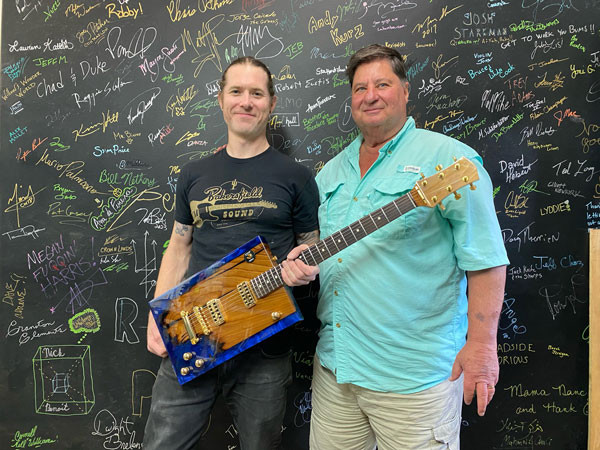 Close-up of the blue epoxy block encasing the ancient cypress wood, the raw material for a unique guitar build.
Close-up of the blue epoxy block encasing the ancient cypress wood, the raw material for a unique guitar build.
Before diving into the build process, let’s address the inspiration behind this unconventional project: the legendary Bo Diddley. Bo Diddley, a pivotal figure in music history, was instrumental in bridging the gap between blues and rock and roll in the 1950s. His signature sound, characterized by prominent tremolo, reverb, and overdriven amplifiers—uncommon for his time—set him apart. Beyond his sonic innovations, Bo Diddley popularized the “Bo Diddley beat,” a rhythm rooted in Afro-Cuban clave and Southern “hambone” traditions, famously heard in hits like “Who Do You Love?”. Perhaps most visually iconic was his self-designed, rectangular cigar box-shaped guitar, developed in collaboration with Gretsch Guitars.
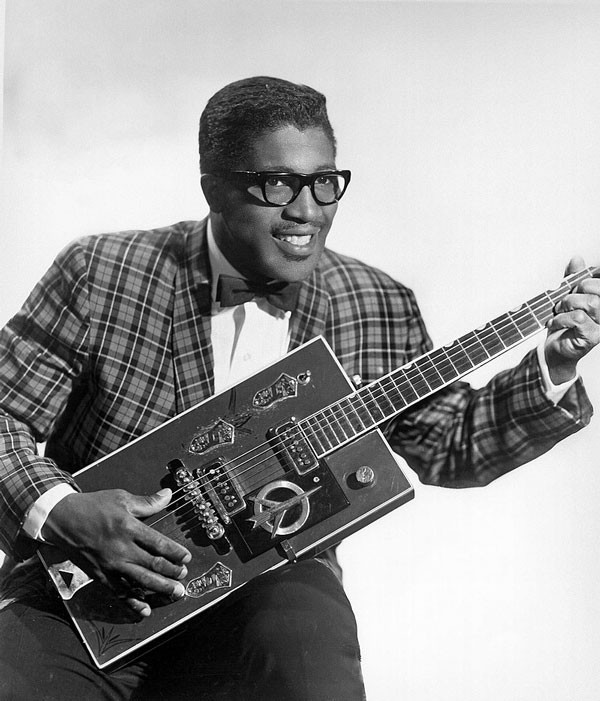 Bo Diddley, a rock and roll pioneer, pictured in a 1957 publicity shot holding his iconic rectangular "Twang Machine" Gretsch guitar.
Bo Diddley, a rock and roll pioneer, pictured in a 1957 publicity shot holding his iconic rectangular "Twang Machine" Gretsch guitar.
A Piece of History Becomes a Guitar Body
The connection between Bo Diddley and this ancient wood runs deeper than mere aesthetics. Bo Diddley himself acknowledged his Louisiana bayou roots, stating, “My people are from New Orleans, the bayou country — French, African, Indian, all mixed up. That’s where my music comes from, all that mixture.” For Mike, utilizing this artifact to create a guitar for Bo Diddley’s grandson, Garry “Reese” Mitchell, felt like a meaningful tribute.
The cypress fragment encased in epoxy is far from ordinary. This 800-year-old bald cypress was once part of a pirogue unearthed near Grand Isle, Louisiana, in 2005, after Hurricane Cindy eroded it from a marsh in Lafitte, Louisiana. Discovered 30 miles south of its original location, its significance was documented by the Louisiana Archeological Society. Radiocarbon dating at the University of Louisiana at Lafayette confirmed its age, solidifying its historical importance. Before reaching our workshop, Mike ensured the artifact’s spiritual readiness for transformation by having it blessed by Grayhawk Perkins of the Tribal Council of the United Houma Nation.
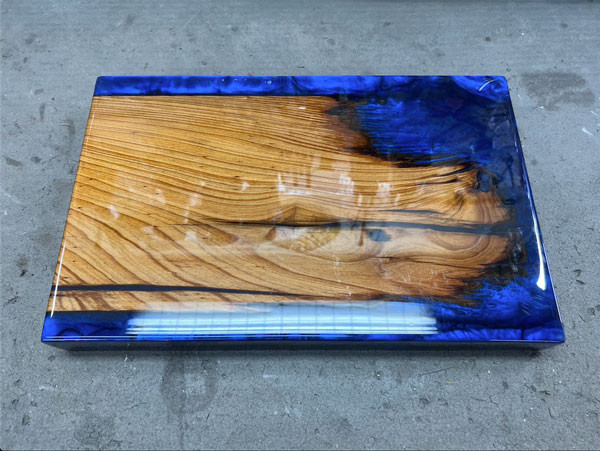 A section of the ancient bald cypress dugout canoe, crafted by the Chitimacha people around 1220 A.D., preserved in epoxy.
A section of the ancient bald cypress dugout canoe, crafted by the Chitimacha people around 1220 A.D., preserved in epoxy.
Building the Bo Diddley Inspired Instrument
With the historical and musical significance established, the guitar construction commenced. We sourced an All-Parts paddle head neck and received a generous donation of gold hardware from Hartley Peavey. TV Jones pickups were selected to capture the vintage tone. The build process then moved into our workshop, beginning with the foundational steps.
 Close up shot of the epoxy block guitar body, showing pencil lines marking the centerline and scale length for precise instrument construction.
Close up shot of the epoxy block guitar body, showing pencil lines marking the centerline and scale length for precise instrument construction.
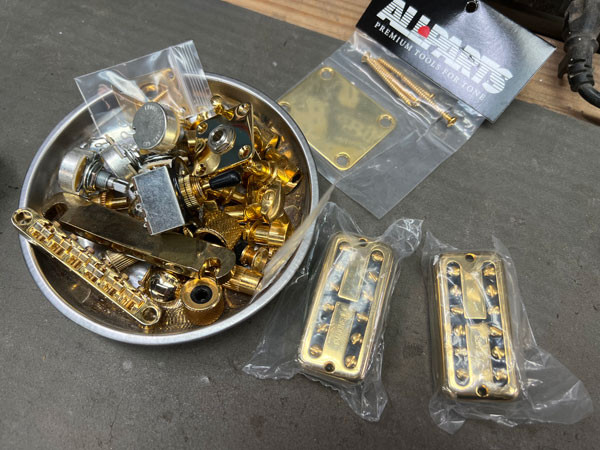 Overhead view of the epoxy guitar body, showcasing layout lines indicating the neck pocket and pickup placement for accurate routing.
Overhead view of the epoxy guitar body, showcasing layout lines indicating the neck pocket and pickup placement for accurate routing.
The initial tasks involved establishing the centerline and scale length on the epoxy block, crucial for accurate instrument geometry. Following these lines, the neck pocket routing began.
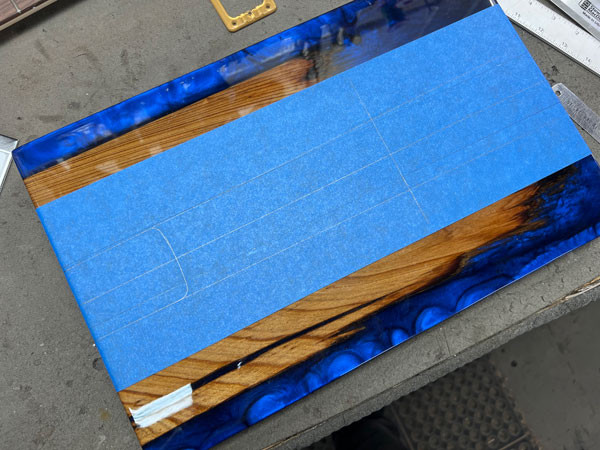 Angled view of the guitar body during the neck pocket routing process, showcasing the initial cuts being made into the epoxy material.
Angled view of the guitar body during the neck pocket routing process, showcasing the initial cuts being made into the epoxy material.
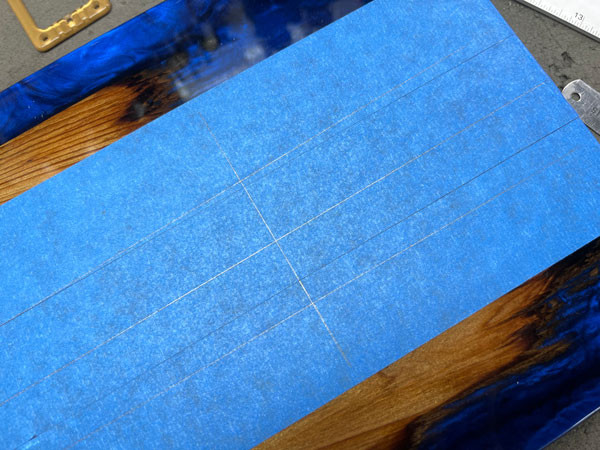 Close-up of the routing template and router bit engaged in cutting the neck pocket into the epoxy guitar body, ensuring precise dimensions.
Close-up of the routing template and router bit engaged in cutting the neck pocket into the epoxy guitar body, ensuring precise dimensions.
Precision was paramount. A specialized router template ensured the neck pocket was cut to exacting specifications, guaranteeing a snug and proper neck fit.
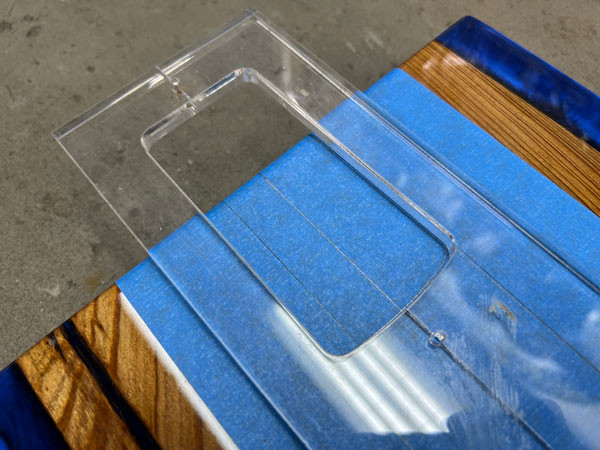 Image showing the clean and precisely routed neck pocket in the epoxy guitar body, ready to receive the guitar neck.
Image showing the clean and precisely routed neck pocket in the epoxy guitar body, ready to receive the guitar neck.
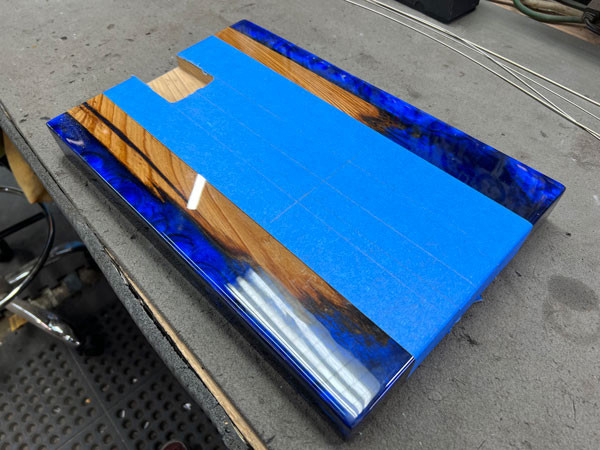 View of the guitar body with the neck temporarily placed in the newly routed neck pocket, checking for fit and alignment before proceeding.
View of the guitar body with the neck temporarily placed in the newly routed neck pocket, checking for fit and alignment before proceeding.
With the neck pocket complete, the next step was to locate and drill the holes for the bridge studs.
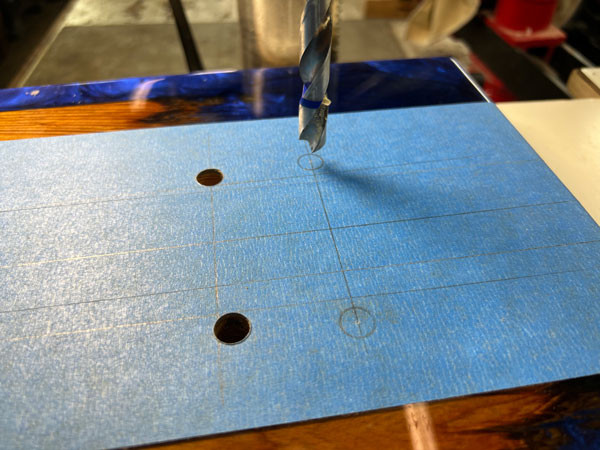 Close-up of the drill press precisely drilling holes for the bridge studs into the prepared guitar body, ensuring correct placement.
Close-up of the drill press precisely drilling holes for the bridge studs into the prepared guitar body, ensuring correct placement.
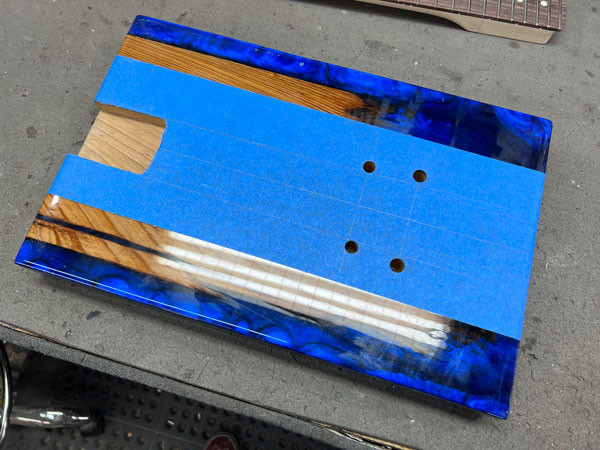 Image showing the bridge stud bushings being installed into the drilled holes in the guitar body, preparing for bridge mounting.
Image showing the bridge stud bushings being installed into the drilled holes in the guitar body, preparing for bridge mounting.
Following the bridge hardware, templates were employed again, this time to route the cavities for the TV Jones pickups.
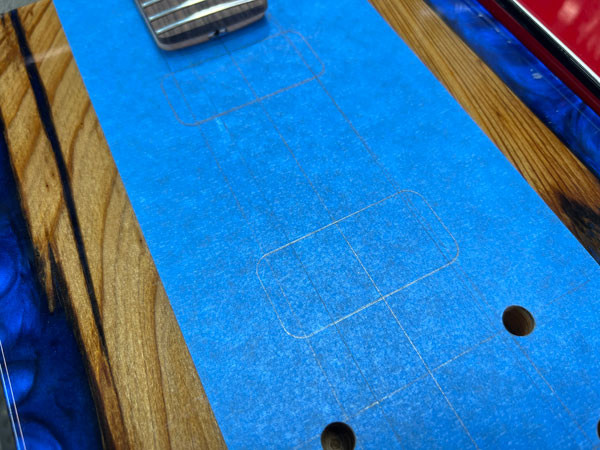 Router carefully cutting the pickup cavity using a template designed for TV Jones pickups, ensuring a precise fit for the electronics.
Router carefully cutting the pickup cavity using a template designed for TV Jones pickups, ensuring a precise fit for the electronics.
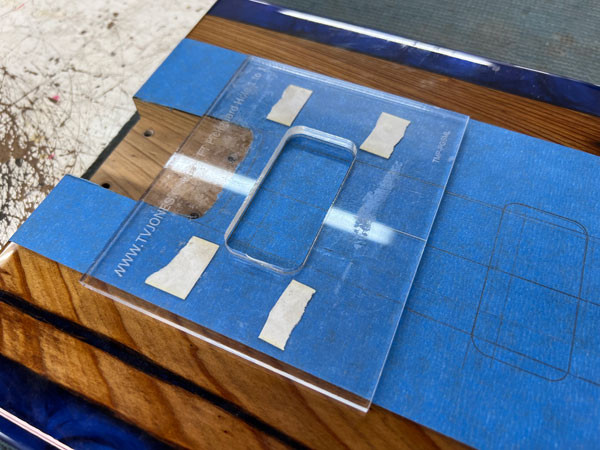 Close-up of the pickup cavity routing process in progress, showing the router bit removing material to create space for the pickups.
Close-up of the pickup cavity routing process in progress, showing the router bit removing material to create space for the pickups.
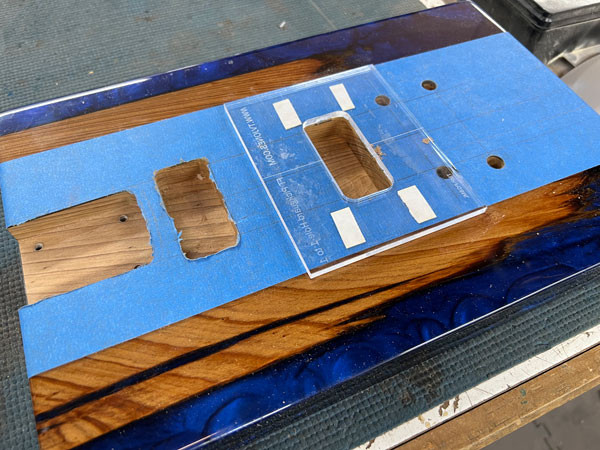 Completed pickup cavities routed into the guitar body, ready to house the TV Jones pickups and contribute to the guitar's sound.
Completed pickup cavities routed into the guitar body, ready to house the TV Jones pickups and contribute to the guitar's sound.
Electronics and Finishing Touches
With the major cavities routed, attention shifted to the guitar’s electronics layout.
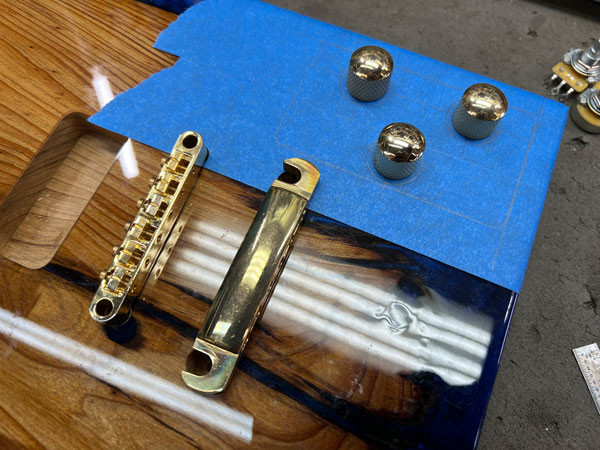 Image showing the planning stage of the electronics layout, with components positioned on the guitar body to determine wiring paths and control placement.
Image showing the planning stage of the electronics layout, with components positioned on the guitar body to determine wiring paths and control placement.
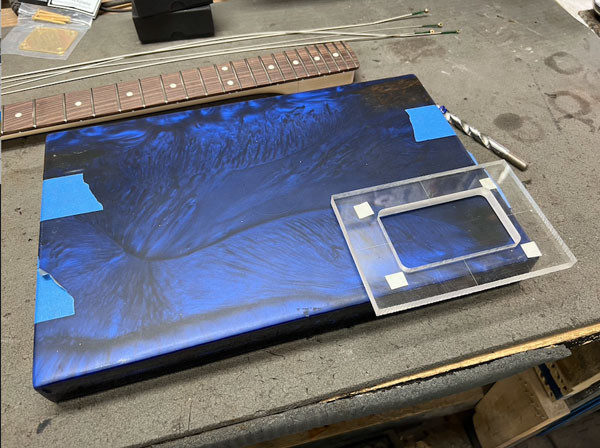 Diagram illustrating a typical guitar wiring schematic, demonstrating the complexity and connections involved in guitar electronics.
Diagram illustrating a typical guitar wiring schematic, demonstrating the complexity and connections involved in guitar electronics.
The sheer volume of epoxy was notable, requiring careful and considered routing and wiring.
 Side view of the epoxy block showing its thickness and density, illustrating the material challenges in crafting this unique guitar body.
Side view of the epoxy block showing its thickness and density, illustrating the material challenges in crafting this unique guitar body.
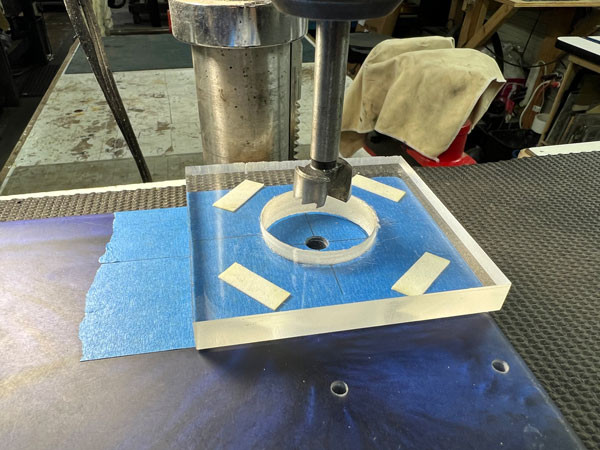 Luthier using a Festool plunge router, a favored tool for precision woodworking and guitar making, to refine cavities in the epoxy body.
Luthier using a Festool plunge router, a favored tool for precision woodworking and guitar making, to refine cavities in the epoxy body.
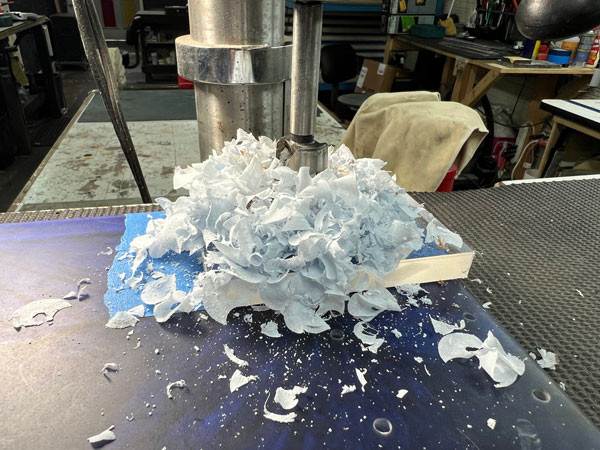 Festool plunge router in action, demonstrating its role in creating clean and accurate routs in the guitar body for electronic components.
Festool plunge router in action, demonstrating its role in creating clean and accurate routs in the guitar body for electronic components.
Our Festool plunge router proved invaluable for achieving clean and precise routs in the dense epoxy.
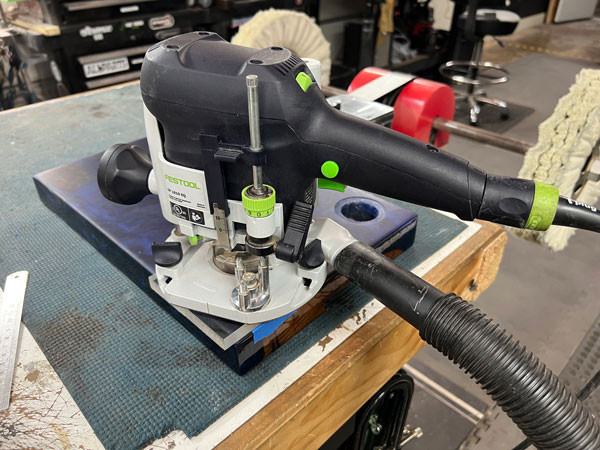 Close-up of the Festool plunge router, highlighting its features and precision capabilities that are essential for guitar building.
Close-up of the Festool plunge router, highlighting its features and precision capabilities that are essential for guitar building.
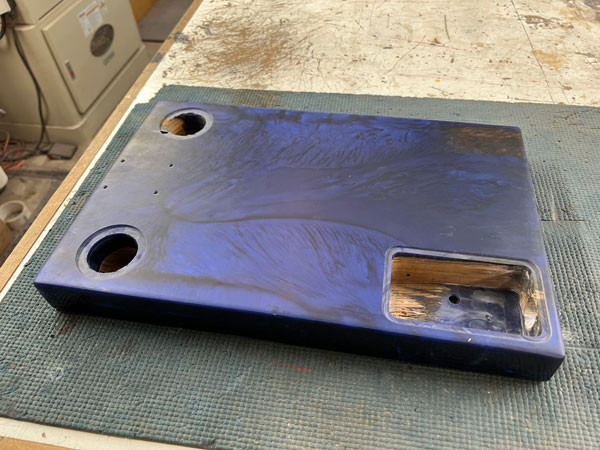 Applying electronic shielding paint to the interior cavities of the guitar body, protecting the electronics from unwanted interference.
Applying electronic shielding paint to the interior cavities of the guitar body, protecting the electronics from unwanted interference.
To minimize electrostatic interference, electronic shielding paint was applied to the interior cavities, ensuring a clean signal path.
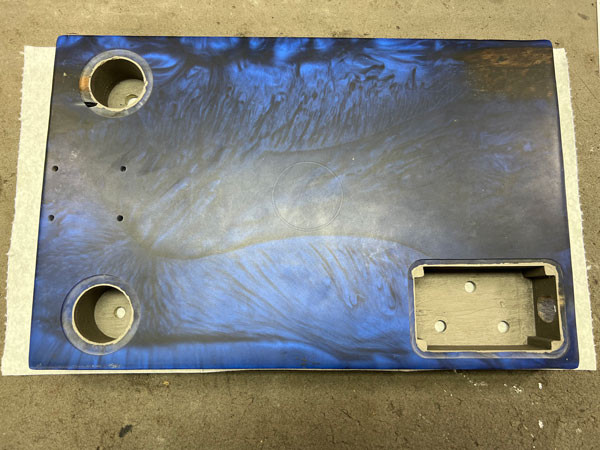 Image of the guitar body after applying shielding paint, now drying and ready for the electronic components to be installed.
Image of the guitar body after applying shielding paint, now drying and ready for the electronic components to be installed.
Once the shielding paint dried, the intricate process of wiring the guitar began.
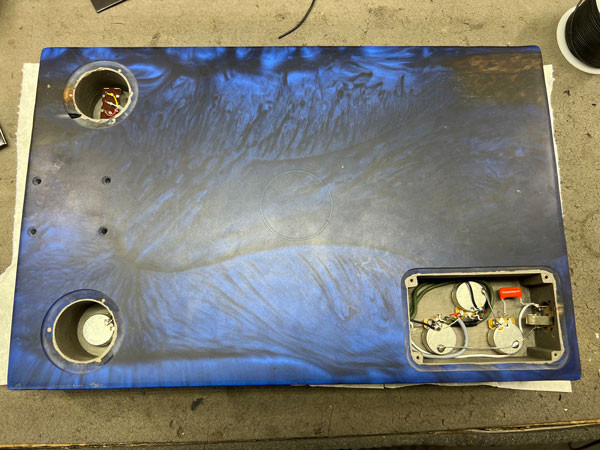 Detailed view of the guitar's wiring process, showing the careful soldering and connection of electronic components within the guitar body.
Detailed view of the guitar's wiring process, showing the careful soldering and connection of electronic components within the guitar body.
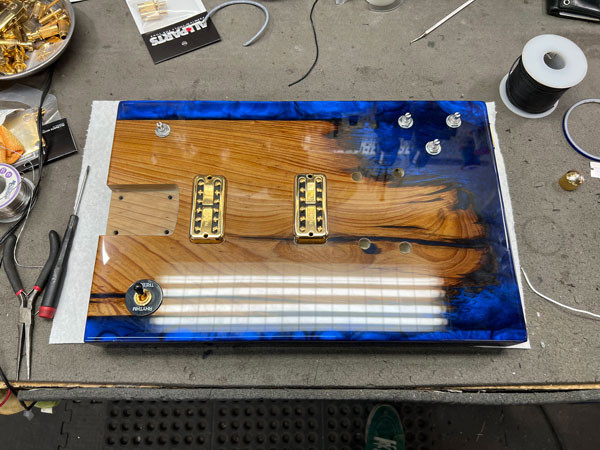 Close-up of the meticulously wired electronics inside the guitar body, showcasing the precision and care taken in the wiring process.
Close-up of the meticulously wired electronics inside the guitar body, showcasing the precision and care taken in the wiring process.
With the body’s wiring complete, attention turned to the neck and headstock. Reclaimed cypress from an old New Orleans porch column was chosen to create a headstock veneer, providing an aesthetic link to the body’s cypress origins.
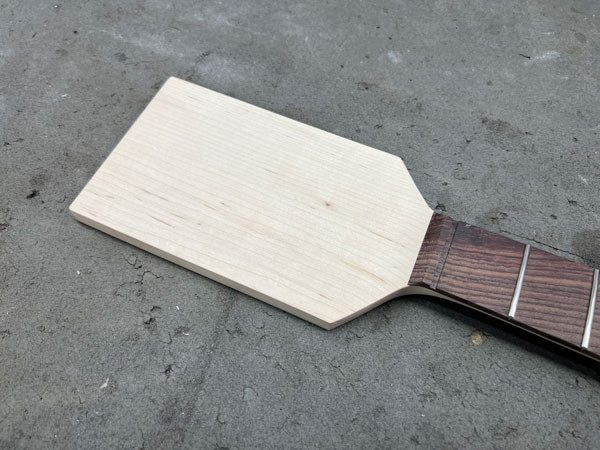 Selection of reclaimed cypress wood, sourced from an old New Orleans porch column, to be used for the guitar headstock veneer.
Selection of reclaimed cypress wood, sourced from an old New Orleans porch column, to be used for the guitar headstock veneer.
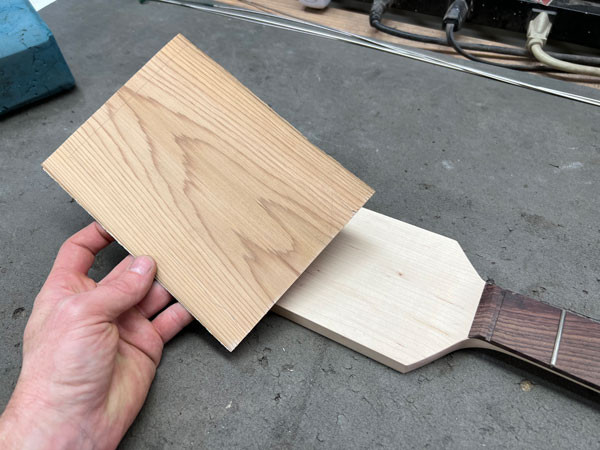 Close-up of the reclaimed cypress piece, highlighting its grain and texture, chosen for the headstock veneer to match the body's aesthetic.
Close-up of the reclaimed cypress piece, highlighting its grain and texture, chosen for the headstock veneer to match the body's aesthetic.
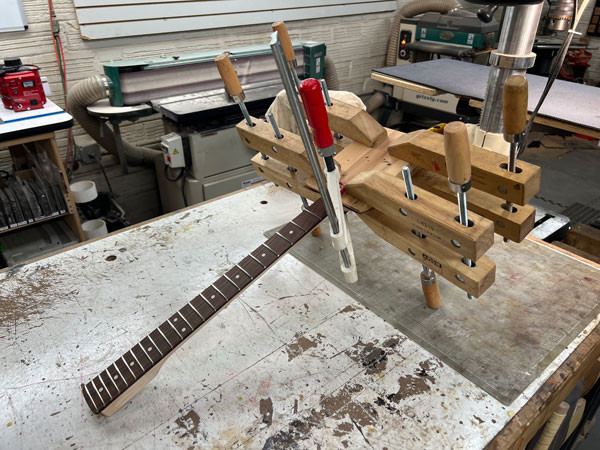 Cypress veneer being carefully applied to the guitar headstock, adding a visual and material connection to the guitar body.
Cypress veneer being carefully applied to the guitar headstock, adding a visual and material connection to the guitar body.
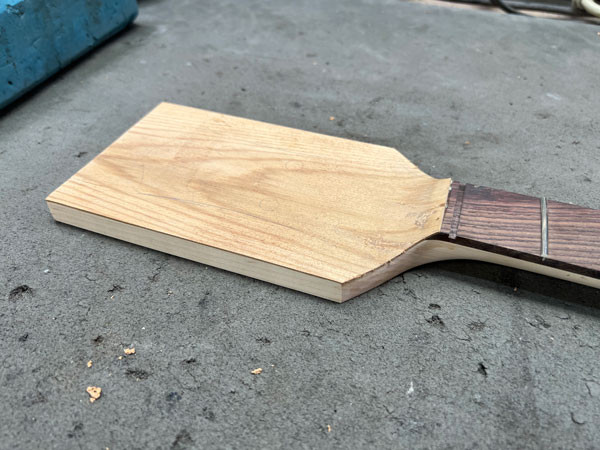 Headstock veneer application process, showing the cypress being shaped and adhered to the guitar neck headstock.
Headstock veneer application process, showing the cypress being shaped and adhered to the guitar neck headstock.
The headstock shape was designed to be reminiscent of classic designs while retaining a unique identity.
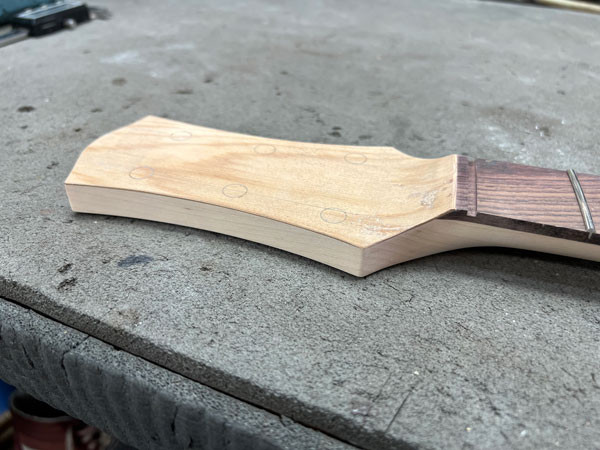 Shaped guitar headstock with the cypress veneer applied, showcasing a design that balances classic elements with unique features.
Shaped guitar headstock with the cypress veneer applied, showcasing a design that balances classic elements with unique features.
To mirror the body’s glossy finish, clear lacquer was applied to the headstock face, creating visual harmony.
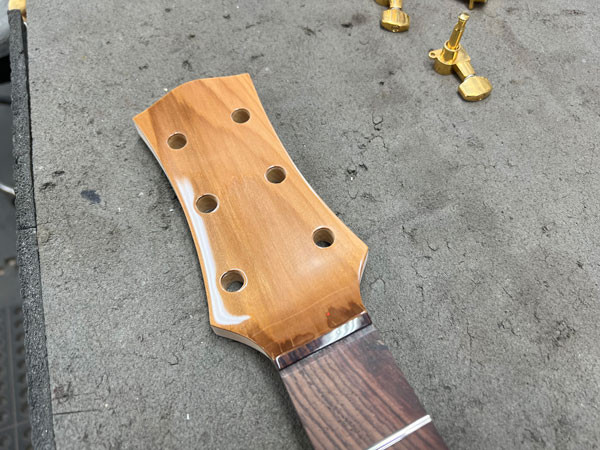 Headstock after finishing with clear lacquer, achieving a shine that complements the guitar body and enhances the wood grain.
Headstock after finishing with clear lacquer, achieving a shine that complements the guitar body and enhances the wood grain.
Black vinyl pickguard material was used to fashion sleek control plates, adding a final touch of visual contrast and refinement.
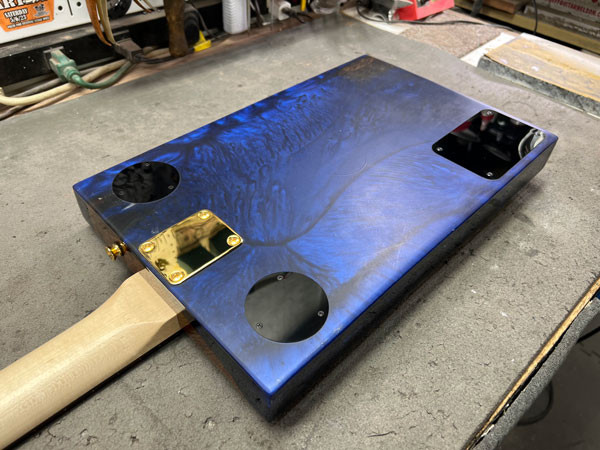 Custom black control plates crafted from vinyl pickguard material, adding a stylish and functional element to the guitar's design.
Custom black control plates crafted from vinyl pickguard material, adding a stylish and functional element to the guitar's design.
Final Setup and Completion
The final stages involved fret leveling using our Plek machine and crafting a new bone nut. Following these precision adjustments, the guitar underwent its final setup.
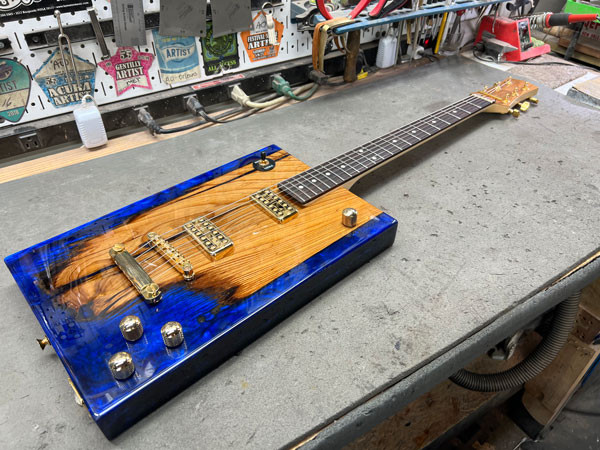 Guitar neck undergoing fret leveling on the Plek machine, ensuring optimal playability and intonation.
Guitar neck undergoing fret leveling on the Plek machine, ensuring optimal playability and intonation.
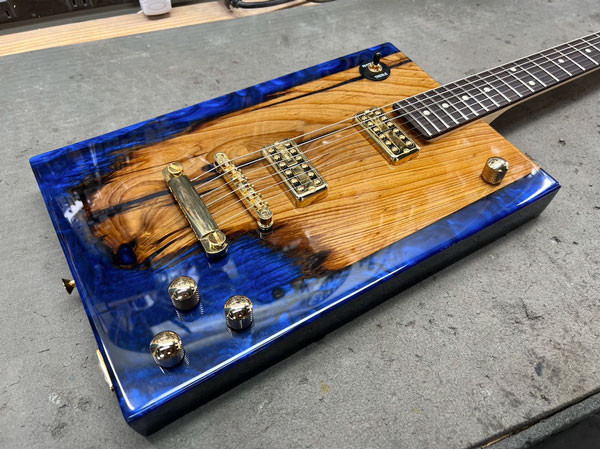 Close-up of the completed guitar, highlighting the control knobs and bridge hardware, showcasing the finished craftsmanship.
Close-up of the completed guitar, highlighting the control knobs and bridge hardware, showcasing the finished craftsmanship.
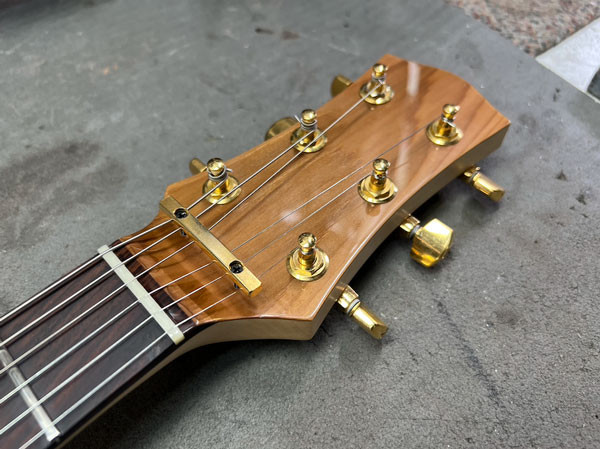 Full view of the completed Bo Diddley inspired guitar, showcasing its unique rectangular shape and the blend of historical wood with modern components.
Full view of the completed Bo Diddley inspired guitar, showcasing its unique rectangular shape and the blend of historical wood with modern components.
The result is a unique bo diddley guitar, a testament to craftsmanship, history, and musical legacy. Bo Diddley, with his innovative spirit, would undoubtedly appreciate this distinctive instrument.
